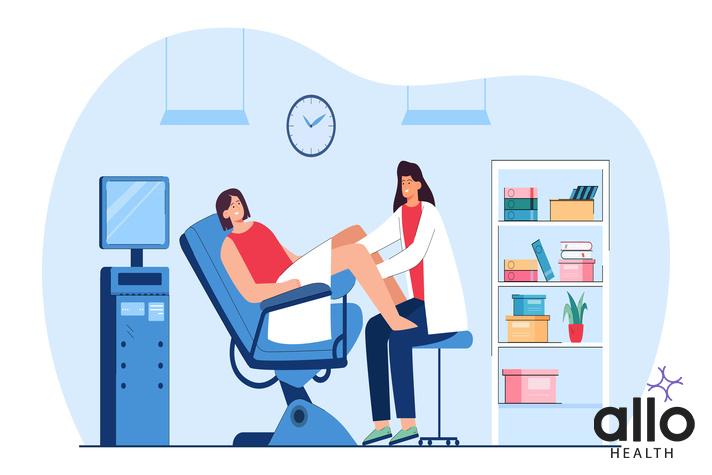What Is Bacterial Vaginosis?

Allo Health is dedicated to personalized well-being, offering support and trusted information tailored to individual health goals. The platform emphasizes human-generated content, led by a distinguished medical team of experts, including physicians and sexual health specialists. Their commitment to credibility involves rigorous fact-checking, authoritative research, and continuous updates to ensure accurate, up-to-date information. Allo Health's unique approach goes beyond conventional platforms, providing expert-led insights and a continuous commitment to excellence, with user feedback playing a crucial role in shaping the platform's authoritative voice.

Dr.Sanjana holds a MBBS degree from Vydehi Medical Institute and Research Centre, Bangalore. She has extensive experience working in numerous multispeciality hospitals and digital platforms. Her vast knowledge in the field of sexual wellness along with her ability to connect/empathise with her patients makes her guide patients to make informed decisions for themselves.
Why This Was Upated?
Our experts continually monitor the health and wellness space, and we update our articles when new information became available.
Updated on 20 May, 2024
- Article was updated as part of our commitment to diversity, equity, and inclusion.

"The following blog article provides general information and insights on various topics. However, it is important to note that the information presented is not intended as professional advice in any specific field or area. The content of this blog is for general educational and informational purposes only.
Book consultation
The content should not be interpreted as endorsement, recommendation, or guarantee of any product, service, or information mentioned. Readers are solely responsible for the decisions and actions they take based on the information provided in this blog. It is essential to exercise individual judgment, critical thinking, and personal responsibility when applying or implementing any information or suggestions discussed in the blog."
What is Bacterial Vaginosis?
Bacterial Vaginosis is a condition that occurs when the balance of bacteria in the vagina is disrupted. Normally, the vagina is home to a healthy balance of good bacteria (Lactobacillus) and bad bacteria. BV occurs when there is an overgrowth of bad bacteria, which can cause unpleasant symptoms like itching, burning, and discharge.
The exact cause of BV is not known, but it has been linked to a number of factors, including sexual activity, douching, and the use of certain types of contraceptives.
Causes of Bacterial Vaginosis
BV is caused by an overgrowth of certain bacteria in the vagina, particularly Gardnerella vaginalis. The exact cause of the bacterial imbalance is not clear, but it is thought to be related to the following factors:
- Douching: Douching disrupts the natural balance of bacteria in the vagina, making it more susceptible to BV.
- Antibiotics: Antibiotics can kill both good and bad bacteria in the body, including those in the vagina, leading to an overgrowth of harmful bacteria.
- Sexual activity: Although BV is not an STI, it is more common in women who are sexually active, particularly those with multiple sexual partners or a new partner
- Hormonal changes: Hormonal changes during pregnancy, menstruation, and menopause can also disrupt the natural balance of bacteria in the vagina.
Symptoms of Bacterial Vaginosis
Many women with BV do not experience any symptoms. However, when symptoms do occur, they may include:
- Vaginal discharge: A thin, gray or white discharge from the vagina which may resemble cottage cheese
- Smell: A strong fishy smell that may become stronger after sex
- Itching or irritation: Itching or irritation around the vulva and vagina.
- Pain during urination : BV can cause pain or burning during urination.
- Pain during sex: BV can also cause pain or discomfort during sexual intercourse.
It is important to note that these symptoms can also be a sign of other vaginal infections, such as yeast infections or STIs. Therefore, it is important to seek medical attention if you experience any of these symptoms.
Risk Factors of Bacterial Vaginosis
- Sexual Activity: Engaging in sexual activity, especially with a new partner, increases the risk of developing bacterial vaginosis. This is because the bacteria from your partner’s genital area can mix with your own vaginal bacteria, leading to an imbalance. Multiple sexual partners and unprotected sex can also increase the risk of BV.
-
Douching: Douching is a common practice among women, but it can actually be harmful to vaginal health. Douching involves flushing the vagina with water or other fluids to clean it. However, this practice can disrupt the natural balance of bacteria in the vagina, making it more susceptible to infections like BV. Experts recommend avoiding douching and letting the vagina clean itself naturally.
- Antibiotics: Antibiotics are powerful medications that can be used to treat various bacterial infections. However, they can also disrupt the balance of bacteria in the vagina, making it more susceptible to BV. Women who have recently taken antibiotics may be at increased risk of developing bacterial vaginosis.
- Hormonal Changes: Hormonal changes in the body, such as those that occur during pregnancy, menstruation, or menopause, can also increase the risk of developing BV. These changes can alter the pH balance of the vagina, creating an environment that is more conducive to the growth of harmful bacteria.
- Diabetes: Diabetes is a chronic condition that affects the body’s ability to regulate blood sugar levels. Women with diabetes are more likely to develop bacterial vaginosis, as high blood sugar levels can promote the growth of harmful bacteria in the vagina.
- Personal Hygiene: Maintaining good personal hygiene is important for vaginal health, but certain practices can increase the risk of BV. For example, wearing tight-fitting clothing, using scented hygiene products, and not changing out of wet clothing promptly can all create an environment that is more conducive to the growth of harmful bacteria.
Types Of Bacteria That Can Cause Bacterial Vaginosis
Gardnerella vaginalis
Gardnerella vaginalis is a type of anaerobic bacteria that is commonly found in the vaginal area of women with BV. This bacteria is typically harmless, but when it overgrows, it can cause an imbalance in the vaginal microbiome, leading to BV symptoms.
Atopobium vaginae
Atopobium vaginae is another type of bacteria that has been associated with bacterial vaginosis. This bacteria is also a common inhabitant of the vaginal microbiome, but an overgrowth can lead to an increase in pH, which can trigger BV symptoms.
Prevotella spp.
Prevotella spp. is a type of bacteria that is typically found in the mouth, but it can also be present in the vaginal area. This bacteria is associated with an increase in vaginal pH, which can contribute to the development of bacterial vaginosis.
Peptostreptococcus spp.
Peptostreptococcus spp. is a type of anaerobic bacteria that is commonly found in the vaginal microbiome. While this bacteria is typically harmless, an overgrowth can lead to an increase in vaginal pH, which can contribute to BV.
Bacteroides spp.
Bacteroides spp. is a type of anaerobic bacteria that is commonly found in the intestinal tract, but it can also be present in the vaginal area. This bacteria is associated with an increase in vaginal pH, which can cause bacterial vaginosis symptoms.
Mobiluncus spp.
Mobiluncus spp. is a type of bacteria that is typically found in the vaginal microbiome. An overgrowth of this bacteria can lead to the production of a strong odor, which is a common symptom of bacterial vaginosis.

Treatment of Bacterial Vaginosis
BV can be treated with antibiotics. The most commonly prescribed antibiotic for BV is metronidazole, which can be taken orally or applied topically as a cream or gel. Other antibiotics that may be prescribed include clindamycin or tinidazole.
In addition to antibiotics, probiotics may also be helpful in treating BV. Probiotics are live bacteria and yeasts that are beneficial to the body. They can be taken as supplements or found in certain foods, such as yogurt.
It is important to complete the full course of antibiotics, even if symptoms improve. Failure to complete the full course of antibiotics can lead to a recurrence of BV.

Relationship Between Bacterial Vaginosis and Sexual Health
BV is not classified as an STI, but it is related to sexual health. The exact relationship between BV and sexual activity is not fully understood, but research suggests that there may be a link.
Studies have shown that women who are sexually active are more likely to develop BV than those who are not. This may be because sexual activity can change the pH balance of the vagina, making it easier for bad bacteria to grow.
BV is also more common in women who have multiple sex partners or a new sexual partner. This is because exposure to new bacteria can disrupt the natural balance of bacteria in the vagina.
It is important to note that BV is not always caused by sexual activity. Women who are not sexually active can also develop BV, and there are other factors that can contribute to the development of the condition.
BV and STIs
While BV is not an STI, having BV can increase your risk of getting an STI. This is because the overgrowth of bad bacteria can make it easier for STIs to take hold in the body.
Studies have shown that women with BV are more likely to contract HIV, herpes, chlamydia, and gonorrhea. This is because BV can cause inflammation in the vaginal tissue, making it easier for these infections to enter the body.
BV can also increase the risk of transmitting an STI to a sexual partner. This is because the overgrowth of bad bacteria can make it easier for STIs to be transmitted during sexual activity.
How Can Bacterial Vaginosis Affect Your Sex Life?
BV can have a significant impact on your sex life in several ways:
Discomfort during sex
BV can cause pain or discomfort during sex. The inflammation and irritation caused by the infection can make sex painful or uncomfortable. This can lead to a decrease in sexual desire or even avoidance of sex altogether.
Reduced lubrication
BV can reduce natural lubrication in the vagina, making sex uncomfortable or even painful. This can also increase the risk of vaginal tears or irritation, which can lead to further discomfort.
Embarrassment
The fishy odor associated with BV can be embarrassing, especially during sexual activity. Women may feel self-conscious and avoid sexual contact because of the odor.
Risk of transmission
BV can increase the risk of transmitting other sexually transmitted infections (STIs) like HIV, herpes, and chlamydia. The inflammation and irritation caused by the infection can make it easier for STIs to spread.
How To Minimize The Impact of BV On Your Sex Life?
Fortunately, there are steps you can take to minimize the impact of BV on your sex life:
- Practice good hygiene: Keeping the vaginal area clean and dry can help prevent BV. Avoid using harsh soaps or douching, as these can disrupt the natural balance of bacteria in the vagina.
- Use protection: Using condoms during sex can help reduce the risk of transmitting BV and other STIs.
- See a doctor: If you suspect you have BV, see a doctor for diagnosis and treatment. BV can be treated with antibiotics, which can help alleviate symptoms and reduce the risk of transmission.
- Avoid sex during treatment: If you are being treated for BV, it is important to avoid sexual contact until the infection has cleared up. This will help prevent the spread of the infection and reduce the risk of complications.
What Doctor Do You Go To?
If you suspect that you have bacterial vaginosis, you should see a healthcare provider who specializes in women’s health. Here are the types of doctors you can see:
- Obstetrician-Gynecologist (OB-GYN): An obstetrician-gynecologist, or OB-GYN, is a doctor who specializes in women’s reproductive health. They are trained to diagnose and treat a wide range of conditions related to the female reproductive system, including bacterial vaginosis. OB-GYNs can perform a pelvic exam and order laboratory tests to confirm the diagnosis of BV. They can prescribe antibiotics to treat the infection and provide recommendations for preventing future infections.
- Primary Care Physician (PCP): A primary care physician, or PCP, is a doctor who provides general medical care to patients of all ages. They are trained to diagnose and treat a wide range of conditions, including bacterial vaginosis. If you have a good relationship with your PCP, they can diagnose and treat BV or refer you to a specialist if needed.
- Nurse Practitioner (NP) or Physician Assistant (PA): A nurse practitioner, or NP, or physician assistant, or PA, are healthcare providers who can diagnose and treat bacterial vaginosis. They are licensed to prescribe medications and perform minor procedures. If you don’t have a primary care physician or gynecologist, you can see an NP or PA for diagnosis and treatment of BV.
Prevention of Bacterial Vaginosis
There are several steps women can take to reduce their risk of developing BV, including:
- Avoid douching: Douching can disrupt the natural balance of bacteria in the vagina, making it more susceptible to BV.
- Practice safe sex: Using condoms during sexual activity can reduce the risk of developing BV.
- Limit the number of sexual partners: Having multiple sexual partners increases the risk of developing BV.
- Avoid using perfumed products: Perfumed soaps, lotions, and other products can irritate the vagina, making it more susceptible to BV.
- Wear cotton underwear: Opt for cotton or underwear made from cotton fabric. Bacteria tend to flourish in damp surroundings, but cotton aids in drawing away moisture
You Shouldn’t Be Embarrassed About Having Bacterial Vaginosis
- It’s common: Bacterial vaginosis is one of the most common vaginal infections in women of reproductive age. Therefore, it’s important to remember that you are not alone in experiencing this infection.
- It’s not a reflection of your hygiene: Contrary to popular belief, bacterial vaginosis is not caused by poor hygiene. It is a bacterial imbalance that can occur in any woman, regardless of how clean she is. Therefore, it’s important to not blame yourself or feel ashamed for something that is not within your control.
- It’s easily treatable: Bacterial vaginosis is easily treatable with antibiotics. In most cases, a short course of oral or topical antibiotics can clear up the infection within a few days. Therefore, there is no need to suffer in silence or let the infection go untreated out of embarrassment.
- It’s important to seek treatment: Left untreated, bacterial vaginosis can lead to complications such as pelvic inflammatory disease (PID), which can cause infertility. Therefore, it’s important to seek treatment as soon as possible if you suspect that you have BV.
- It’s not a reflection of your sexual behavior: As mentioned earlier, bacterial vaginosis is not a sexually transmitted infection. While certain sexual behaviors can increase the risk of developing BV, such as having multiple partners, it’s important to remember that the infection can occur in women who are not sexually active as well.
Frequently Asked Questions
- What causes bacterial vaginosis (BV)? Bacterial vaginosis is primarily caused by an imbalance in the natural vaginal microbiome, where certain bacteria overgrow, leading to a disruption in the healthy balance. The exact cause is not always clear, but various factors like sexual activity, douching, and antibiotic use can contribute to its development.
- What are the common symptoms of BV? The most typical symptoms of bacterial vaginosis include a strong, fishy odor, often accompanied by a grayish-white vaginal discharge. However, some women with BV may experience no noticeable symptoms. It’s essential to consult a healthcare provider for a proper diagnosis and treatment.
- Is bacterial vaginosis a sexually transmitted infection (STI)? No, bacterial vaginosis is not classified as a sexually transmitted infection, although sexual activity can increase the risk of developing BV. It is an imbalance of the vaginal microbiome rather than a direct result of sexual transmission. Nevertheless, women with multiple sexual partners or a new sexual partner may be at a higher risk of developing BV.
- How is bacterial vaginosis diagnosed? Diagnosis of BV typically involves a healthcare provider performing a pelvic exam and examining a sample of vaginal discharge. In some cases, they may also use pH or amine tests to confirm the diagnosis. Laboratory tests can help differentiate BV from other vaginal infections.
- What are the treatment options for bacterial vaginosis? Bacterial vaginosis is usually treated with antibiotics, most commonly metronidazole or clindamycin. Your healthcare provider will determine the appropriate treatment and dosage. It’s crucial to complete the full course of antibiotics to ensure the infection is completely cleared. Additionally, probiotics and lifestyle changes, such as avoiding douching and using condoms during sexual activity, may help prevent recurrent episodes of BV.






































